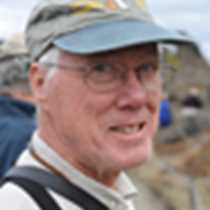Cape Horn & the Beagle Channel
Cape Horn, the southernmost point of South America, is one of the world’s great geographical features. It was left behind when South America pulled away from Antarctica some 38 million years ago to complete the breakup of the great southern megacontinent that we now call Gondwana. It is exposed to the westerly winds and frequent storms of the “Furious Fiftys.”
During the age of sail over 800 vessels and 10,000 sailors were lost attempting to “round Cape Horn,” most of them struggling to go east to west, Atlantic to Pacific, against the winds. Sailors of that era believed that the souls of their lost brethren were carried on the wings of the soaring albatrosses, hence the bad luck associated with the killing of an albatross by Samuel Taylor Coleridge’s poem about an ancient mariner.
This morning we completed our northbound transit of the “Docile Drake.” Albatrosses and other seabirds increased in numbers as we neared Cape Horn. We passed close enough to the Cape to view a monument dedicated to the lost mariners. It is a beautiful piece, formed of offset sheets of steel cut so that, when viewed from the south, they align to form the silhouette of a soaring albatross.
There is a poem in Spanish on a marble plaque along the path leading to the monument:
Soy el albatros que te espera
En el final del mundo.
Soy el alma olvidada de los marinos muertos
Que cruzaron el Cabo de Hornos
Desde todos los mares de la tierra.
Pero ellos no murieron
En las furiosas olas.
Hoy vuelan en mis alas,
Hacia la eternidad,
En la ultima grieta
De los vientos Antarcticos
This translates as follows:
I am the albatross who awaits you
At the end of the earth.
I am the forgotten soul of the dead mariners
who rounded Cape Horn
from all the seas of the world.
But they did not perish
in the furious waves.
Today they fly on my wings
For all eternity
in the final embrace
of the Antarctic winds.
- Sara Vial
December, 1992
And so we entered the Beagle Channel, passing green-clad slopes. An afternoon slide show of images taken during our voyage caused us to reflect upon our experiences, but the most enduring images are those that we carry within … of the cacophony of a penguin colony, the whoosh of the blow of a humpback whale, the silence of the ice, the enormity and grandeur of Antarctica. May it ever be so.
Cape Horn, the southernmost point of South America, is one of the world’s great geographical features. It was left behind when South America pulled away from Antarctica some 38 million years ago to complete the breakup of the great southern megacontinent that we now call Gondwana. It is exposed to the westerly winds and frequent storms of the “Furious Fiftys.”
During the age of sail over 800 vessels and 10,000 sailors were lost attempting to “round Cape Horn,” most of them struggling to go east to west, Atlantic to Pacific, against the winds. Sailors of that era believed that the souls of their lost brethren were carried on the wings of the soaring albatrosses, hence the bad luck associated with the killing of an albatross by Samuel Taylor Coleridge’s poem about an ancient mariner.
This morning we completed our northbound transit of the “Docile Drake.” Albatrosses and other seabirds increased in numbers as we neared Cape Horn. We passed close enough to the Cape to view a monument dedicated to the lost mariners. It is a beautiful piece, formed of offset sheets of steel cut so that, when viewed from the south, they align to form the silhouette of a soaring albatross.
There is a poem in Spanish on a marble plaque along the path leading to the monument:
Soy el albatros que te espera
En el final del mundo.
Soy el alma olvidada de los marinos muertos
Que cruzaron el Cabo de Hornos
Desde todos los mares de la tierra.
Pero ellos no murieron
En las furiosas olas.
Hoy vuelan en mis alas,
Hacia la eternidad,
En la ultima grieta
De los vientos Antarcticos
This translates as follows:
I am the albatross who awaits you
At the end of the earth.
I am the forgotten soul of the dead mariners
who rounded Cape Horn
from all the seas of the world.
But they did not perish
in the furious waves.
Today they fly on my wings
For all eternity
in the final embrace
of the Antarctic winds.
- Sara Vial
December, 1992
And so we entered the Beagle Channel, passing green-clad slopes. An afternoon slide show of images taken during our voyage caused us to reflect upon our experiences, but the most enduring images are those that we carry within … of the cacophony of a penguin colony, the whoosh of the blow of a humpback whale, the silence of the ice, the enormity and grandeur of Antarctica. May it ever be so.



